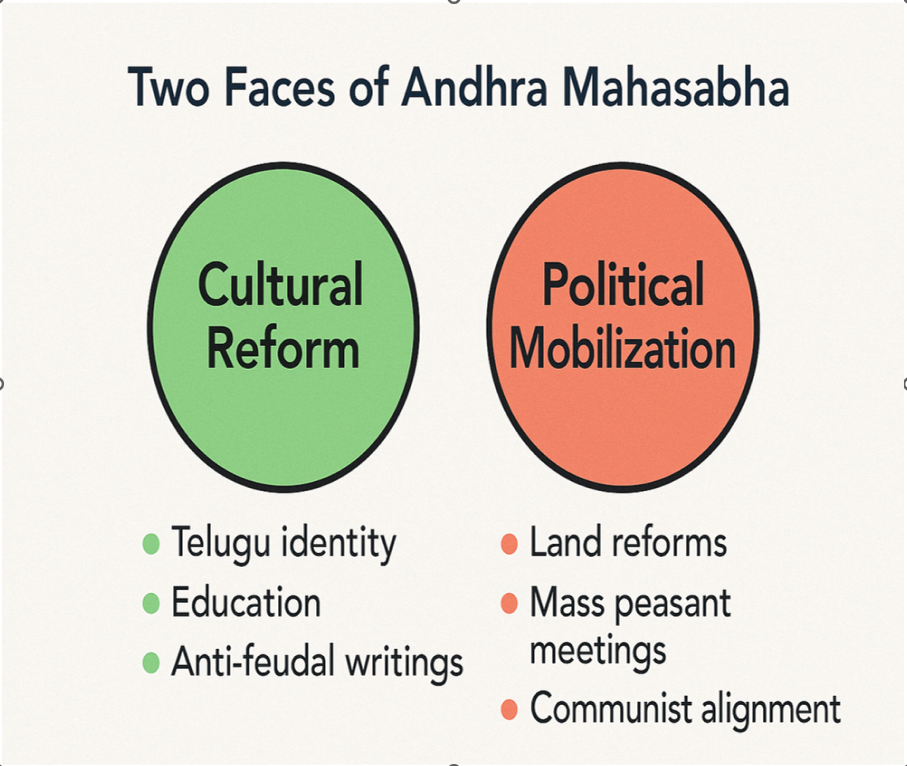There are no items in your cart
Add More
Add More
| Item Details | Price | ||
|---|---|---|---|
Thu Apr 24, 2025
Approach:
Introduction:
• The Andhra Mahasabha, founded in 1930 under Suravaram Pratap Reddy, began as a socio-cultural forum and gradually became a key driver of political mobilization in rural Telangana against Nizam’s feudal rule.
Body:
Andhra Mahasabha’s Transformative Role:
1. Transition from Cultural to Political Agenda:
-Shifted focus from literary and social reform to rural issues like feudalism, illiteracy, and lack of services.
2. Grassroots Mobilization of Peasantry:
-Empowered rural communities, especially in Nalgonda and Warangal, to protest exploitation.
3. Advocacy for Land Reforms:
-Addressed land inequality; laid foundation for redistribution debates.
4. Foundation for Telangana Armed Struggle:
-Ideological precursor to the 1946–51 uprising; platform for radical rural resistance.
5. Ideological Realignment:
-Factional division into communists and moderates signified deepening political involvement.
6. Post-Independence Political Legacy:
-Many leaders entered mainstream politics, influencing Telangana's future governance.
Structural Limitations and Challenges:
1. Elite-Centric Origins:
-Urban leadership delayed effective rural outreach.
2. Delayed Political Action:
-Missed early chances to address rural unrest.
3. Ideological Fragmentation:
-1946 split reduced organizational strength.
4. Short Organizational Lifespan:
-Did not survive as a post-independence political entity.
5. Lack of Sustained Rural Advocacy:
-Failed to institutionalize long-term representation of peasants.
Conclusion:
• Despite its short life and internal challenges, the Andhra Mahasabha played a key role in politicizing rural Telangana and laid the foundation for later resistance and reforms.
Introduction:
The Andhra Mahasabha, which emerged as Telangana’s first political organization, took shape with the 1930 Jogipet meeting led by Suravaram Pratap Reddy. Initially focused on education, social reform, and opposing discriminatory policies under Nizam rule, it gradually transformed into a mass-based platform that politically mobilized rural Telangana against feudal oppression.
Body:
Andhra Mahasabha’s Transformative Role in Rural Telangana
1. Transition from Cultural to Political Agenda
-By the late 1930s, the Mahasabha evolved from a cultural group into a platform addressing rural grievances such as feudal exploitation and lack of basic services.
2. Grassroots Mobilization of Peasantry
-Actively organized peasants in regions like Nalgonda and Warangal, raising demands against oppressive landlord systems and economic injustices.
3. Advocacy for Land Reforms
-Recognized the exploitative nature of the feudal structure and demanded land redistribution and policies to ensure equitable access for marginalized rural communities, especially peasants and agricultural workers.
4. Lead-Up to Telangana Armed Struggle (1946–51)
-Served as a political incubator for militant rural resistance and laid ideological and organizational groundwork for the communist-led uprising.
5. Ideological Realignment and Political Deepening
-The Andhra Mahasabha split into two factions: extremists who joined the Communist Party of India and moderates who allied with the Hyderabad State Congress, marking its deep entry into active political currents.
6. Contribution to Post-Independence Political Culture
-Many of its leaders later shaped Telangana’s political institutions, demonstrating the lasting political legacy of its rural mobilization efforts.
Structural Limitations and Internal Challenges
1. Initial Elite-Centric Orientation
-Early leadership was dominated by urban educated elites, which restricted early engagement with the rural poor.
2. Delayed Entry into Political Action
-Focused on cultural identity for over a decade before transitioning into active political organization, missing earlier peasant unrest opportunities.
3. Fragmentation through Ideological Split
-The 1946 split weakened the unity and coherence of the movement, diluting its rural momentum.
4. Short Institutional Lifespan
-The Mahasabha failed to sustain itself as a united political organization after independence, unlike the Communist or Congress parties.
5. Absence of a Long-Term Rural Platform
-It did not evolve into a lasting organizational structure to consistently represent peasant interests in post-Nizam democratic politics.
Conclusion:
The Andhra Mahasabha played an important role in connecting cultural awareness with political mobilization in rural Telangana. While it had limitations, its efforts reflected in movements like the Nalgonda peasant uprising helped raise social and political consciousness among peasants.
Additional Embellishment:
